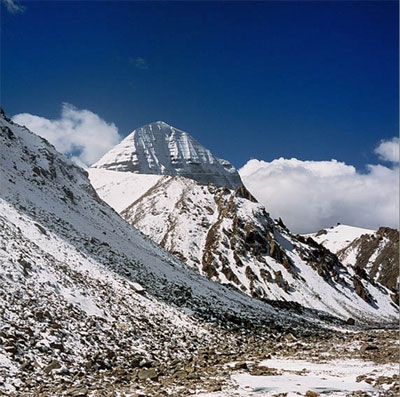 |
Home | About Us | Contact Us | Email | Reservation |
 |
    |
The Holy Mountain Kangrinboqe
Best time to go: on April 15 of the Tibetan calendar
 Ngari is also famous for its holy mountain and lake. The holy mountain,
Kangrinboqe, is the main peak of the Kangdese Mountains. About 6,714 meters
above sea level, the mountain is powerful and imposing, holding a sacred
position in many religions. For hundreds of years, Kangrinboqe has attracted
numerous religious followers and travelers with its many mystical stories
and legends. Thousands of Chinese, overseas religious devotees, and tourists
make pilgrimages or sightsee here every year. These devout followers usually
take a year or longer to reach the sacred mountain, kowtowing all the
way from afar.
Ngari is also famous for its holy mountain and lake. The holy mountain,
Kangrinboqe, is the main peak of the Kangdese Mountains. About 6,714 meters
above sea level, the mountain is powerful and imposing, holding a sacred
position in many religions. For hundreds of years, Kangrinboqe has attracted
numerous religious followers and travelers with its many mystical stories
and legends. Thousands of Chinese, overseas religious devotees, and tourists
make pilgrimages or sightsee here every year. These devout followers usually
take a year or longer to reach the sacred mountain, kowtowing all the
way from afar.
Sumeru Mountain, the place where, according to legend, Sakyamuni performed rites to save the souls of the dead, is regarded as the center of the world in Buddhism. It is also the hall of Siva in Hinduism. People usually dismiss it as nothing than a mythical place, a mountain in conception only. However, Sumeru Mountain is actually a real mountain. It is the Kangrinboqe.
Abhidharma-kosa Sastra describes a journey which, after going northward from India and crossing nine snow mountains, led to a "large snow mountain." It is Kangrinboqe, the main peak of the Kangdese Mountains, extending hundreds of kilometers. Kangrinboqe in Tibetan means "treasure of the snow mountains." The holy mountain looks like an olive rising to the sky. Its peak resembles a colorful hat surrounded by eight lotus pedals, and its body seems to be made of crystal, looking like a jade-inlaid ice sculpture of extremely skillful craftsmanship. Legend has it that when Sakyamuni was still living in this world, Buddha, gods, human beings, Asura (a kind of evil spirit in ancient Indian mythology) and musicians in Heaven gathered around the holy mountain. The gathering took place in the year of horse.
It is said that pilgrims can wash away their lifetime sins after traveling
once around the mountain; they can be exempt from the sufferings in Hell
during the 500 samsara if they travel ten times around the mountain; and,
finally, the pilgrims can become Buddhas during their lifetime and go
to Heaven after death if they circle the mountain a hundred times. If
the pilgrims go around the mountain in the year of horse, which was when
Sakyamuni was born, they can acquire a-dozen-fold charitable and pious
deeds, which equal circling the mountain thirteen times during other years.
For hundreds of years, pilgrims have come in a continuous stream to the
mountain, which has taken deep root in Tibetan religion, history, and
culture. Mystical and fascinating, it is a mountain of spirit, culture,
and belief, a combination of man and divinity, and man and nature. Many
Tibetan religious followers enshrine and worship the picture of Kangrinboqe
together with the figure of Buddha in their homes. Kangrinboqe is a symbol,
not only of natural beauty, but also of a belief.
Send Online Query
| Home | About Us | Contact Us | Email | Reservation |
| Site Designsed & Promoted by Tour of Tibet.com |